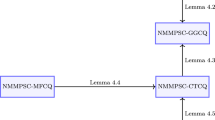Abstract
This paper establishes sufficient conditions for the connectedness of nontrivial subsets of the solution set to linear complementarity systems with special structure. Connectedness may be important to investigate stability and sensitivity questions, parametric problems, and for extending a Lemke-type method to a new class of problems. Such a property may help in analyzing the structure of the feasible region by checking the explicitly given matrices of the resulting conditions. From the point of view of geometry, the question is how to analyze the combined geometrical object consisting of a Riemannian manifold, a pointed cone, and level sets determined by linear inequalities.
Similar content being viewed by others
References
Karamardian, S.,The Complementarity Problem, Mathematical Programming, Vol. 2, pp. 107–129, 1972.
Cottle, R. W.,Complementarity and Variational Problems, Symposia Mathematica, Academic Press, New York, New York, Vol. 19, pp. 177–208, 1976.
Cottle, R. W., Giannessi, F., andLions, J. L., Editors,Variational Inequalities and Complementarity Problems, John Wiley and Sons, New York, New York, 1980.
Giannessi, F., andTomasin, E.,Nonconvex Quadratic Programming, Linear Complementarity Problems, and Integer Linear Programs, Mathematical Programming in Theory and Practice, Edited by P. L. Hammer and A. B. Zoutendijk, North-Holland, Amsterdam, Holland, pp. 161–199, 1974.
Cohn, M. Z., andMaier, G., Editors,Engineering Plasticity by Mathematical Programming, Pergamon Press, Oxford, England, 1979.
Luk, F. T., andPagano, M.,Quadratic Programming with M-Matrices, Linear Algebra and Its Applications, Vol. 33, pp. 15–40, 1980.
Judice, J. J., andMitra, G.,Reformulation of Mathematical Programming Problems as Linear Complementarity Problems and Investigation of Their Solution Methods, Journal of Optimization Theory and Applications, Vol. 57, pp. 123–149, 1988.
Rapcsák, T.,Geodesic Convexity in Nonlinear Optimization, Journal of Optimization Theory and Applications, Vol. 69, pp. 169–183, 1991.
Hicks, N. J.,Notes on Differential Geometry, Van Nostrand Publishing Company, Princeton, New Jersey, 1965.
Samelson, H., Thrall, R. M. andWesler, O.,A Partitioning Theorem for Euclidean n-Space, Proceedings of the American Mathematical Society, Vol. 9, pp. 805–807, 1958.
Avriel, M., Diewert, W. E., Schaible, S., andZang, I.,Generalized Concavity, Plenum Press, New York, New York, 1988.
Author information
Authors and Affiliations
Additional information
Communicated by F. Giannessi
This paper has been mainly prepared while the author was visiting the Department of Mathematics at the University of Pisa. This research was partialy supported by the Hungarian National Research Foundation, Grant No. OTKA-2568.
Rights and permissions
About this article
Cite this article
Rapcsák, T. On the connectedness of the solution set to linear complementarity systems. J Optim Theory Appl 80, 501–512 (1994). https://doi.org/10.1007/BF02207777
Issue Date:
DOI: https://doi.org/10.1007/BF02207777



